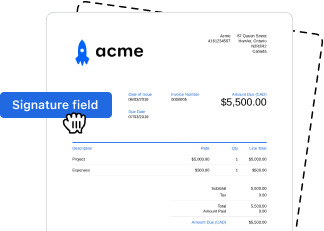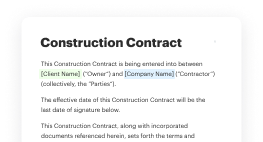Digital Signature Legality for Payroll Deduction Authorization in Australia
- Quick to start
- Easy-to-use
- 24/7 support
Simplified document journeys for small teams and individuals




We spread the word about digital transformation
Why choose airSlate SignNow
-
Free 7-day trial. Choose the plan you need and try it risk-free.
-
Honest pricing for full-featured plans. airSlate SignNow offers subscription plans with no overages or hidden fees at renewal.
-
Enterprise-grade security. airSlate SignNow helps you comply with global security standards.







Your complete how-to guide - digital signature legality for payroll deduction authorization in australia
Digital Signature Legality for Payroll Deduction Authorization in Australia
When it comes to setting up Payroll Deduction Authorization in Australia, digital signatures play a crucial role in ensuring legality and security. Companies can benefit from using airSlate SignNow to streamline this process efficiently.
How to Use airSlate SignNow for Digital Signature Legality in Payroll Deduction Authorization:
- Launch the airSlate SignNow web page in your browser.
- Sign up for a free trial or log in.
- Upload a document you want to sign or send for signing.
- If you're going to reuse your document later, turn it into a template.
- Open your file and make edits: add fillable fields or insert information.
- Sign your document and add signature fields for the recipients.
- Click Continue to set up and send an eSignature invite.
airSlate SignNow empowers businesses to send and eSign documents with an easy-to-use, cost-effective solution. It offers a great ROI with its rich feature set, tailored for SMBs and Mid-Market. The platform also provides transparent pricing with no hidden support fees and add-on costs, along with superior 24/7 support for all paid plans.
Take advantage of airSlate SignNow to simplify your Payroll Deduction Authorization process and ensure legal compliance with digital signatures in Australia.
How it works
Rate your experience
What is the digital signature legality for payroll deduction authorization in Australia
The digital signature legality for payroll deduction authorization in Australia pertains to the acceptance and recognition of electronic signatures in the context of payroll-related documents. In Australia, the Electronic Transactions Act 1999 establishes the legal framework for electronic signatures, ensuring that they hold the same validity as traditional handwritten signatures when specific conditions are met. This means that employers can use digital signatures to authorize payroll deductions, provided that the signatory has given their consent and that the signature is linked to the signatory in a way that verifies their identity.
How to use the digital signature legality for payroll deduction authorization in Australia
To effectively use digital signatures for payroll deduction authorization, organizations must first ensure compliance with the Electronic Transactions Act. This involves implementing a secure eSignature solution, like airSlate SignNow, that allows employees to fill out and sign payroll deduction forms electronically. Users can initiate the process by uploading the payroll deduction authorization document to the platform, filling in the required fields, and then sending it to the relevant parties for signature. Once all signatures are obtained, the completed document can be securely stored and managed digitally.
Steps to complete the digital signature legality for payroll deduction authorization in Australia
Completing a payroll deduction authorization using digital signatures involves several key steps:
- Prepare the payroll deduction authorization document in a digital format.
- Upload the document to airSlate SignNow and fill in the necessary details, such as employee information and deduction amounts.
- Send the document for signature to the employee and any other required signatories.
- Monitor the signing process through the platform to ensure all parties have completed their signatures.
- Once signed, securely store the completed document in compliance with legal requirements.
Security & Compliance Guidelines
When utilizing digital signatures for payroll deduction authorization, it is crucial to adhere to security and compliance guidelines. This includes ensuring that the eSignature solution complies with the Electronic Transactions Act and other relevant regulations. Organizations should implement robust security measures, such as encryption and secure access controls, to protect sensitive employee information. Additionally, maintaining an audit trail of all signed documents can provide transparency and accountability, which is essential for compliance with legal standards.
Examples of using the digital signature legality for payroll deduction authorization in Australia
Digital signatures can streamline various payroll processes. For instance, an employee may need to authorize a new health insurance deduction. By using airSlate SignNow, the employee can quickly fill out the authorization form and eSign it from their mobile device. This not only speeds up the process but also ensures that the authorization is legally binding. Another example is for employees who wish to change their retirement plan contributions; they can easily submit a digital authorization without the need for physical paperwork, enhancing efficiency and reducing administrative burdens.
Digital vs. Paper-Based Signing
Choosing between digital and paper-based signing for payroll deduction authorization has significant implications for efficiency and compliance. Digital signing offers advantages such as faster processing times, reduced paper use, and easier document management. Unlike traditional paper-based methods, which can involve delays due to mailing or in-person signatures, digital signatures can be completed in real-time. This not only enhances the employee experience but also helps organizations maintain compliance with legal requirements more effectively.
-
Best ROI. Our customers achieve an average 7x ROI within the first six months.
-
Scales with your use cases. From SMBs to mid-market, airSlate SignNow delivers results for businesses of all sizes.
-
Intuitive UI and API. Sign and send documents from your apps in minutes.
FAQs
-
What is the digital signature legality for payroll deduction authorization in Australia?
In Australia, digital signatures are legally recognized under the Electronic Transactions Act 1999. This means that payroll deduction authorization documents signed digitally are valid and enforceable, provided they meet specific criteria. Businesses can confidently use digital signatures for payroll processes, ensuring compliance with Australian laws.
-
How does airSlate SignNow ensure compliance with digital signature legality for payroll deduction authorization in Australia?
airSlate SignNow adheres to the legal standards set forth by Australian legislation regarding digital signatures. Our platform incorporates advanced security measures and audit trails to ensure that all signed documents, including payroll deduction authorizations, are compliant with the digital signature legality for payroll deduction authorization in Australia.
-
What features does airSlate SignNow offer for managing payroll deduction authorizations?
airSlate SignNow provides a user-friendly interface for creating, sending, and managing payroll deduction authorizations. Key features include customizable templates, automated reminders, and real-time tracking of document status. These features streamline the process while ensuring adherence to the digital signature legality for payroll deduction authorization in Australia.
-
Is there a cost associated with using airSlate SignNow for payroll deduction authorizations?
Yes, airSlate SignNow offers various pricing plans tailored to meet the needs of businesses of all sizes. Our plans are designed to be cost-effective while providing robust features for managing payroll deduction authorizations. Investing in our solution ensures compliance with the digital signature legality for payroll deduction authorization in Australia.
-
Can airSlate SignNow integrate with other payroll systems?
Absolutely! airSlate SignNow seamlessly integrates with various payroll systems and software, enhancing your workflow. This integration allows for efficient management of payroll deduction authorizations while ensuring compliance with the digital signature legality for payroll deduction authorization in Australia.
-
What are the benefits of using digital signatures for payroll deduction authorizations?
Using digital signatures for payroll deduction authorizations offers numerous benefits, including increased efficiency, reduced paperwork, and enhanced security. Digital signatures are legally binding and help businesses comply with the digital signature legality for payroll deduction authorization in Australia, making the process faster and more reliable.
-
How secure is airSlate SignNow for handling payroll deduction authorizations?
airSlate SignNow prioritizes security with advanced encryption and authentication measures. Our platform ensures that all payroll deduction authorizations are securely signed and stored, complying with the digital signature legality for payroll deduction authorization in Australia. You can trust that your sensitive information is protected.
Related searches to digital signature legality for payroll deduction authorization in australia
Join over 28 million airSlate SignNow users
Get more for digital signature legality for payroll deduction authorization in australia
- Unlock Electronic Signature Legality for Notice of ...
- Ensuring Electronic Signature Legality for Letter of ...
- Ensuring Electronic Signature Legality for Employee ...
- Unlock the Power of Electronic Signature Legality for ...
- Unlock Electronic Signature Legality for Employee ...
- Electronic Signature Legality for Business Ethics and ...
- Electronic Signature Legality for Polygraph Consent
- Electronic Signature Legality for Drug Testing Consent ...




























